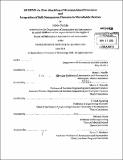| dc.contributor.advisor | Brian L. Wardle. | en_US |
| dc.contributor.author | Fachin, Fabio | en_US |
| dc.contributor.other | Massachusetts Institute of Technology. Department of Aeronautics and Astronautics. | en_US |
| dc.date.accessioned | 2014-03-19T15:43:25Z | |
| dc.date.available | 2014-03-19T15:43:25Z | |
| dc.date.copyright | 2011 | en_US |
| dc.date.issued | 2011 | en_US |
| dc.identifier.uri | http://hdl.handle.net/1721.1/85759 | |
| dc.description | Thesis: Ph. D., Massachusetts Institute of Technology, Department of Aeronautics and Astronautics, 2011. | en_US |
| dc.description | Cataloged from PDF version of thesis. | en_US |
| dc.description | Includes bibliographical references (pages 145-157). | en_US |
| dc.description.abstract | The last two decades have seen a proliferation of fields and applications where microtechnologies have gradually replaced, and often outperformed, their macroscopic counterparts. From engineering to basic sciences, Micro-Electro-Mechanical-Systems (MEMS) are enabling a variety of functionalities that traditional technologies cannot provide, such as miniaturized biomedical platforms capable of detecting and targeting extremely rare particles in blood. Nonetheless, intrinsic limitations in state-of-the-art MEMS processes and materials are hampering further diffusion of microtechnologies, and this thesis work extends MEMS capabilities in two areas: (a) a new technique for three-dimensional (3D) structures for sensing and actuation; and (b) introduction of new bulk nanoporous elements in microfluidics to enhance the efficiency of existing microfluidic platforms and to enable access to sub-micron bioparticles. In the first area, although some efforts to achieve fully 3D microdevices are present in the literature, state-of-the-art MEMS devices are largely planar two-dimensional (2D) structures and are therefore intrinsically limited in their ability to sense and actuate. Here, a new approach to 3D MEMS is demonstrated where structures are designed to operate in the post-buckling regime, thus exploiting buckling phenomena to achieve functional elements that extend out of the wafer plane. An analytical approach to 3D MEMS design and characterization is presented, based on non-linear (post-)buckling of layered structures, including boundary flexibility (non-ideal clamping). One use of the model is the simultaneous extraction of residual stresses and boundary flexibility based solely on common microbridge test structures, with no need for multiple microbridge lengths, significantly reducing uncertainty (-20X) in the results compared to state-of-the-art characterization methods. A second use of the analytical model is for 3D MEMS design. Several 3D structural element concepts are experimentally demonstrated using CMOS, including an example of simultaneous three-axis thermal accelerometer design with enhanced 2D, and 3D sensing. These contributions extend the capabilities of state-of-the-art microfabrication procedures beyond planar layouts to 3D. Future work includes extension of the post-buckling design approach to elements other than microbridges (e.g., membranes) and to applications such as flow sensors and switches. In the second area of this thesis work, integration of ultra-porous (99% porous) elements comprised of nanoporous forests of vertically-aligned carbon nanotubes (VACNTs) in MEMS is demonstrated, particularly their use in microfluidic applications for bioparticle manipulation. Introduction of porous materials in microfluidic devices significantly benefits MEMS by providing an alternative to current solid materials and designs (e.g., PDMS, silicon). The performance of some state-of-the-art microfluidic devices is hampered by detrimental flow characteristics that cause streamlines that drive particles away from the desired (solid) functional surfaces, hence hindering physical interaction between the target species and the functional elements. Porous microfluidic elements enhance particle-surface interactions by enabling fluid flow both around and through the functional elements, e.g., particles smaller than the VACNT pore size (-80nm) can be captured inside the porous elements. To date, inclusion of porous materials into microfluidic platforms has however largely been limited to low porosity and permeability polymer membranes, plugs and monoliths. Here, we demonstrate ultra-porous (99% porous) VACNT forests as a new microfluidic structural material. The in-plane geometry of VACNT elements can be accurately defined through photolithography of the CNT catalyst, while manipulation of VACNT growth conditions enables control of the elements' out-of-plane height to create high aspect-ratio features up to mm-scale heights. Distinct from prior works where the effects of fluids on VACNT forests would result in either structural deformation or catastrophic forest collapse, VACNT elements have been integrated into microfluidic channels such that element geometry is preserved even under flow-through conditions. Simultaneous multiphysics (mechanical and chemical), multiscale (three orders of magnitude in size, from cells to viruses) bioparticle isolation on a single chip using VACNT designs is experimentally demonstrated. A direct comparison between nanoporous (VACNT) and solid (PDMS) designs shows increased (-7X) capture efficiency when transitioning to nanoporous elements. The fluid accessibility of VACNT elements is investigated, yielding permeability levels comparable to that of much larger macro-/micro-scopic porous elements. An analytical discussion of the effects of element porosity on permeability is also presented, revealing critical design considerations for porous materials in microfluidic applications. Additional efforts will be placed on further characterizing the microfluidic properties of nanoporous VACNT elements and the extension of these materials to fields beyond the biomedical sphere. | en_US |
| dc.description.statementofresponsibility | by Fabio Fachin. | en_US |
| dc.format.extent | 166 pages | en_US |
| dc.language.iso | eng | en_US |
| dc.publisher | Massachusetts Institute of Technology | en_US |
| dc.rights | M.I.T. theses are protected by copyright. They may be viewed from this source for any purpose, but reproduction or distribution in any format is prohibited without written permission. See provided URL for inquiries about permission. | en_US |
| dc.rights.uri | http://dspace.mit.edu/handle/1721.1/7582 | en_US |
| dc.subject | Aeronautics and Astronautics. | en_US |
| dc.title | 3D MEMS via (post-) buckling of micromachined structures and integration of bulk nanoporous elements in microfluidic devices | en_US |
| dc.title.alternative | Three dimensional Micro-Electro-Mechanical-Systems via (post-) buckling of micromachined structures and integration of bulk nanoporous elements in microfluidic devices | en_US |
| dc.type | Thesis | en_US |
| dc.description.degree | Ph. D. | en_US |
| dc.contributor.department | Massachusetts Institute of Technology. Department of Aeronautics and Astronautics | |
| dc.identifier.oclc | 871254479 | en_US |
